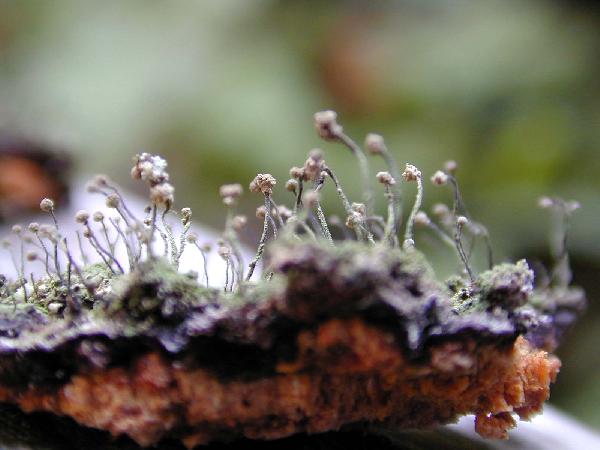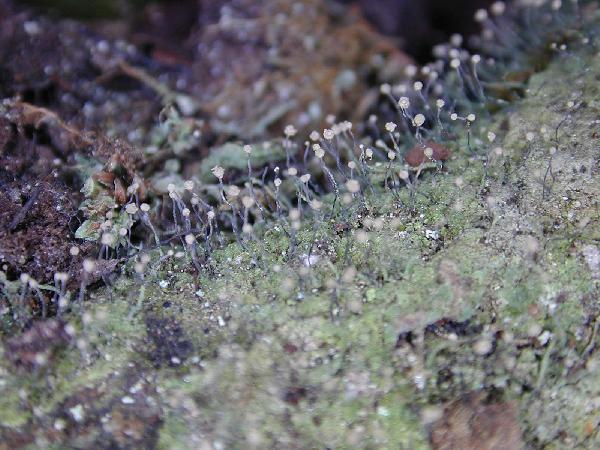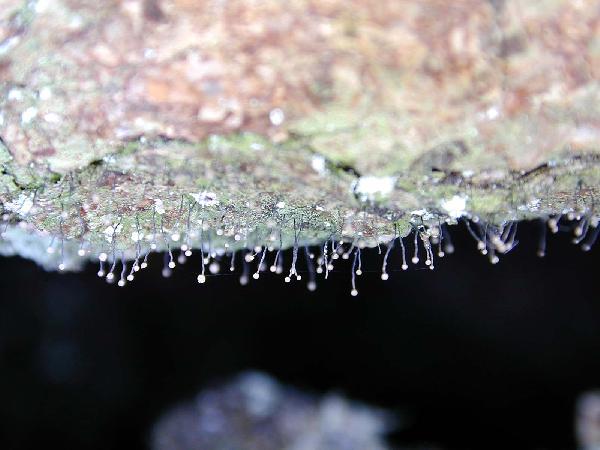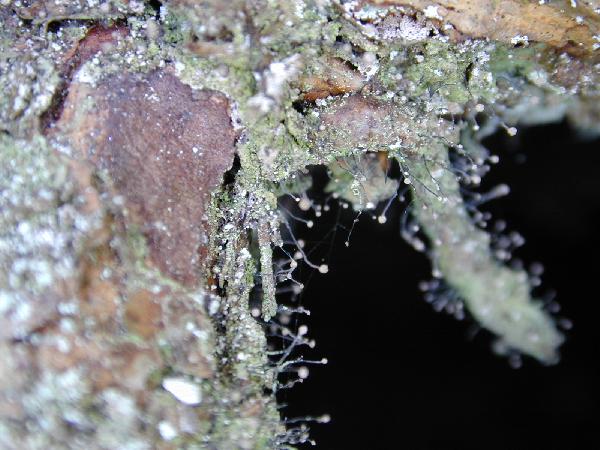Chaenotheca gracilenta (Ach.) Mattsson & Middelb.
in Middelborg & Mattsson, Sommerfeltia 5: 45, 1987. Basionym: Calicium gracilentum Ach. - Lichenogr. Univ.: 243, 1810.
Synonyms: Coniocybe gracilenta (Ach.) Ach.; Cybebe gracilenta (Ach.) Tibell
Distribution: N - Frl (Puntillo & Puntillo 2009), Ven (Nascimbene 2008c), TAA (Nascimbene & al. 2006e, 2022, Thor & Nascimbene 2007, Puntillo & Puntillo 2009, Nascimbene 2014, Nascimbene & Marini 2015, Nimis & al. 2015, Trindade & al. 2021), Lomb (Puntillo & Puntillo 2009), Piem (TSB 33502). C - Tosc (Puntillo & Puntillo 2009), Umb (Ravera & al. 2023b).
Description: Thallus crustose, thinly episubstratic, farinose, grey-green. Apothecia long-stalked, pin-like, 2-3.5 mm high. Stalk slender and flexuose, 0.06-0.09 mm thick, black, but covered in a thin, grey, granular pruina, consisting of periclinally arranged, medium brown hyphae, the outermost layer disrupted into pruina-like granules. Capitulum spherical, 0.2-0.4 mm across, with a poorly developed exciple which is continuous with the stalk tissue. Mazaedium well-developed, pale grey; hypothecium medium brown, formed as a continuation of the stalk, c. 120-150 µm wide and 65-90 µm high. Asci ellipsoid, formed in chains from ascogenous hyphae without hooks, dissolving early. Ascospores 1-celled, very pale brown to almost hyaline, globose, 2.5-3 µm wide, with a smooth to slightly cracked wall. Photobiont chlorococcoid, with rectangular cells (Stichococcus). Spot tests: thallus K-, C-, KC-, P-. Chemistry: thallus with small amounts of several unidentified substances. Note: a circumboreal-montane species found on rotting wood and decaying bark, on faces protected from rain such as hollows of old stumps in ancient, humid, montane to subalpine forests, reported from the Alps and the Northern Apennines. It is included in the Italian red list of epiphytic lichens as “Vulnerable” (Nascimbene & al. 2013c).
Growth form: Crustose
Substrata: bark and lignum
Photobiont: green algae other than Trentepohlia
Reproductive strategy: mainly sexual
In underhangs rarely wetted by rain
Commonnes-rarity: (info)
Alpine belt: absent
Subalpine belt: extremely rare
Oromediterranean belt: absent
Montane belt: very rare
Submediterranean belt: absent
Padanian area: absent
Humid submediterranean belt: absent
Humid mediterranean belt: absent
Dry mediterranean belt: absent

Predictive model
Herbarium samples
Growth form: Crustose
Substrata: bark and lignum
Photobiont: green algae other than Trentepohlia
Reproductive strategy: mainly sexual
In underhangs rarely wetted by rain
Commonnes-rarity: (info)
Alpine belt: absent
Subalpine belt: extremely rare
Oromediterranean belt: absent
Montane belt: very rare
Submediterranean belt: absent
Padanian area: absent
Humid submediterranean belt: absent
Humid mediterranean belt: absent
Dry mediterranean belt: absent

Predictive model
| Herbarium samples |
 INDEX FUNGORUM
INDEX FUNGORUM
 GBIF
GBIF
 DOLICHENS
DOLICHENS









